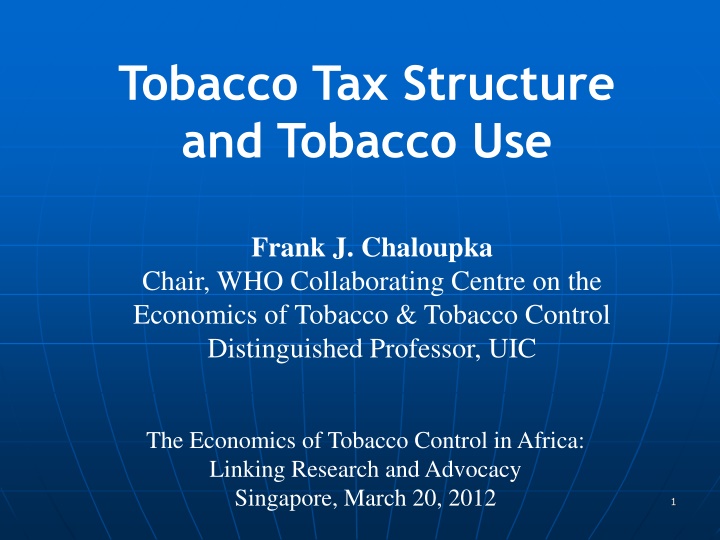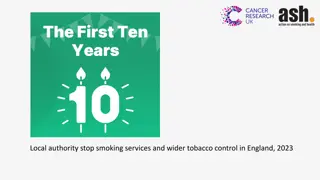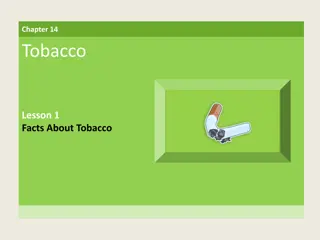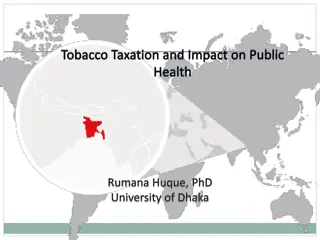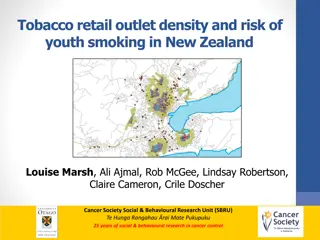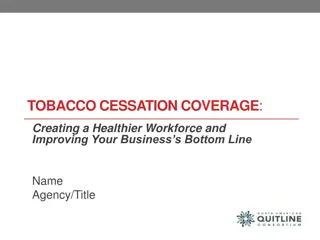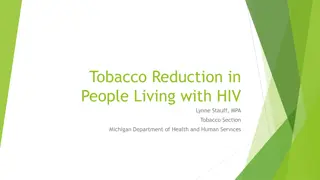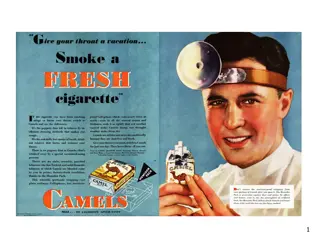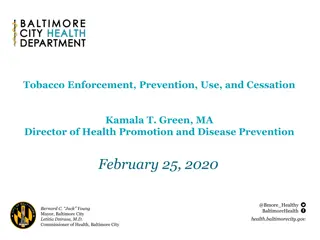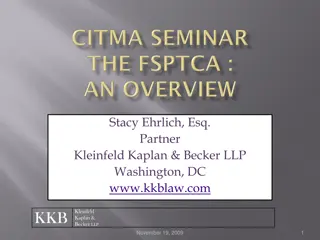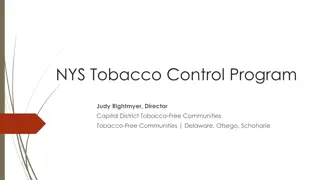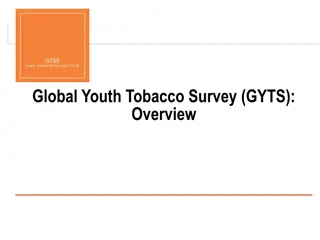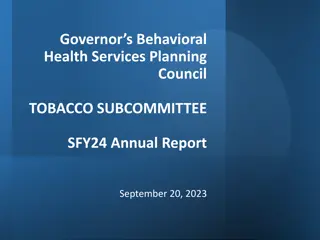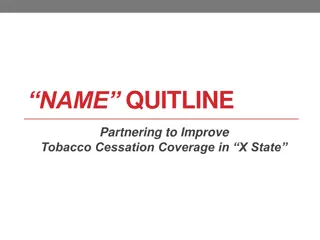Tobacco Taxation Best Practices
The presentation discusses WHO's best practices in tobacco taxation to maximize public health impact by simplifying tax structures, relying more on specific excises, adopting comparable taxes on all tobacco products, and types of tobacco taxes including specific and ad valorem excises. It also highlights global trends in cigarette taxation.
Download Presentation

Please find below an Image/Link to download the presentation.
The content on the website is provided AS IS for your information and personal use only. It may not be sold, licensed, or shared on other websites without obtaining consent from the author.If you encounter any issues during the download, it is possible that the publisher has removed the file from their server.
You are allowed to download the files provided on this website for personal or commercial use, subject to the condition that they are used lawfully. All files are the property of their respective owners.
The content on the website is provided AS IS for your information and personal use only. It may not be sold, licensed, or shared on other websites without obtaining consent from the author.
E N D
Presentation Transcript
Tobacco Tax Structure and Tobacco Use Frank J. Chaloupka Chair, WHO Collaborating Centre on the Economics of Tobacco & Tobacco Control Distinguished Professor, UIC The Economics of Tobacco Control in Africa: Linking Research and Advocacy Singapore, March 20, 2012 1
Best Practices in Tobacco Taxation 2
WHOs Best Practices in Tobacco Taxation Simpler is better Complex tax structures more difficult to administer Greater opportunities for tax evasion and tax avoidance under complex tax structures Where existing structure is more complex, simplify over time with goal of achieving single uniform tax 3
WHOs Best Practices in Tobacco Taxation Rely more on specific tobacco excises as the share of total excises in prices increases Greater public health impact of specific excises given reduced opportunities for switching down in response to tax/price increases Sends clear message that all brands are equally harmful Where existing tax is ad valorem, adopt a specific tax and increase reliance on specific tax over time 4
WHO Best Practices for Tobacco Excise Taxes Adopt comparable taxes and tax increases on all tobacco products Maximizes public health impact of tobacco tax increases by minimizing opportunities for substitution Harm reduction? 5
Types of Tobacco Taxes Tobacco Excise Taxes Two types of excises Specific Taxes: excises based on quantity or weight (e.g. tax per pack of 20 cigarettes) Ad Valorem taxes: excises based on value of tobacco products (e.g. a specific percentage of manufacturer s prices for tobacco products) Some countries use a mix of specific and ad valorem tobacco excises, differential taxes for different products of given type, minimum taxes, etc. Many countries apply different types of taxes and/or tax rates on different types of tobacco products (e.g. manufactured cigarettes vs. bidis) 6
Cigarette Taxation Globally Excise System on Cigarettes Only specific ad valorem Income Group Only Both specific and ad valorem 25 9 No Excise Total countries * High Upper Middle Lower Middle Low By Region AFRO AMRO EMRO EURO SEARO WPRO All Countries 11 16 2 11 7 6 45 42 18 19 12 3 52 10 28 2 3 43 14 13 1 10 3 14 55 29 16 7 3 2 3 60 1 2 5 36 2 2 48 2 3 7 0 1 6 19 46 34 20 49 8 25 182 7 * Countries for which data are available Source: WHO calculations using WHO GTCR 2009 data
Cigarette & Bidi Taxes, India,2009 Total BED 659 NCCD AED Unfiltered Cigarette (Rs. Per 1000) 90 70 819 length 60 mm 1068 145 110 1323 length 60-70mm length 70 mm Filtered Cigarette (Rs. Per 1000) 659 90 70 819 1068 145 110 1323 length 70-75 mm 1424 190 145 1759 length 75 -85mm 1748 235 180 2163 length>85 mm Bidis from producer making <2million sticks/year 0 Bidis other than paper rolled, manufactured without machines (Rs per 1000) 12 12 All Other Bidis (Rs per 1000) 30 30 10 BED: Basic Excise Duty; SED: Special Excise Duty; NCCD: National Calamity Contingency Duty;
Types of Tobacco Taxes Specific taxes: Easier to administer No valuation issues Real value falls with inflation Smaller price gap between high/low priced brands Generally produce more stable stream of revenue Promote higher quality products Producers keeps all of additional price from higher quality products 11
Types of Tobacco Taxes Ad valorem taxes: More difficult to administer given variety of different prices Valuation problems, abusive transfer pricing May require minimum price policies More likely to keep pace with inflation More unstable revenues Government subsidizes industry price cuts but benefits from industry price increases Larger price gap Greater potential for switching down in response to tax increase Favor low quality products Less incentive to invest in quality given price rises by more May be protective for domestic industry if imports or foreign-owned brands tend to be higher quality/price More equitable Absolute amount of tax higher on higher priced brands 12
Types of Tobacco Taxes Mixed systems More difficult to administer given variety of different prices Valuation problems, abusive transfer pricing Better able to keep pace with inflation Somewhat less stable revenues Government still subsidizes industry price cuts and benefits from industry price increases, just not as much Reduced price gap Relative to pure ad valorem More protective for domestic industry Relative to pure specific Somewhat more equitable 13
100.0% Uniform Specific Tax, $0.50 per pack 90.0% $5.00 80.0% Price Gap: $1.60 70.0% $4.00 60.0% $2.90 $3.00 50.0% 40.0% $2.00 30.0% $1.30 20.0% $1.00 10.0% $0.00 0.0% $0.10 $0.50 $0.90 $1.30 $1.70 $2.10 $2.50 14 producer price tax retail price tax as % of price
100.0% Uniform Ad Valorem Tax, 62.5% of Producer Price 90.0% $5.00 80.0% $3.90 Price Gap: $2.60 70.0% $4.00 60.0% $3.00 50.0% 40.0% $2.00 30.0% $1.30 20.0% $1.00 10.0% $0.00 0.0% $0.10 $0.50 $0.90 $1.30 $1.70 $2.10 $2.50 15 producer price tax retail price tax as % of price
100.0% Mixed Ad Valorem Tax, 30% of Producer Price and Specifc Tax, $0.26 per pack OR Minimum Tax of $0.75 per pack 90.0% $5.00 80.0% Price Gap: $1.83 70.0% $4.00 $3.38 60.0% $3.00 50.0% 40.0% $2.00 $1.55 30.0% 20.0% $1.00 10.0% $0.00 0.0% $0.10 $0.50 $0.90 $1.30 $1.70 $2.10 $2.50 16 producer price tax retail price tax as % of price
100.0% $5.40 Tiered Ad Valorem Tax, 62.5%, 83.3%, 125% of Producer Price 90.0% $5.00 80.0% Price Gap: $4.10 70.0% $4.00 60.0% $3.00 50.0% 40.0% $2.00 30.0% $1.30 20.0% $1.00 10.0% $0.00 0.0% $0.10 $0.50 producer price $0.90 $1.30 $1.70 $2.10 $2.50 tax retail price tax as % of price 17
Tax Structure and Tobacco Use EU Analysis: Cigarette prices Cigarette tax revenues Tax paid cigarette sales Smoking Prevalence Mostly 1997-2008 Control for: Economic conditions (real GDP per capita, unemployment rate) Market structure (Herfindahl-Hirschman Index) Country, year fixed effects 18
Structures of excise on cigarettes pack 20 pieces MPPC 5,0 4,0 3,0 2,0 1,0 0,0 BE BG CZ DK DE EE EL ES FR IE IT CY LV LT LU HU MT NL AT PL PT RO SI SK FI SE UK Specifc excise duty Ad Valorem Excise minimum excise tax 19 16 July 2008; Frank Van Driessche, European Commission, Director General for Taxation and the Customs Union
Conclusions Greater reliance on specific tobacco excises: Reduced gap in prices between high and low priced cigarette brands Produced more stable, predictable stream of cigarette excise tax revenues Had greater impact on cigarette smoking Effects vary with market structure 20
Global Adult Tobacco Survey CDC/WHO Partnership Nationally representative, face-to-face household survey of adult (15+) population 14 BGI countries; most complete and released New countries in field or planning stages Data on: tobacco use, cessation, knowledge/attitudes, exposure to tobacco smoke, media influences, economics Key measures: Price, brand choice, tobacco use 21
International Tobacco Control Policy Evaluation Surveys Multiple researchers and funders Cohort surveys of smokers/tobacco users 23 countries; varying start dates, waves Mix of high, middle, low income countries; covers all regions; most of the world s tobacco users Data on: tobacco use, cessation, knowledge/attitudes, exposure to tobacco smoke, media influences, economics; key policy mediators Key measures: Price, brand choice, other purchase behaviors, tobacco use 22
National Cancer Institute UO1 Assess impact of differential tobacco product taxes Most states tax other tobacco products below cigarettes Specific cigarette taxes in all states, ad valorem taxes on other tobacco products in most In recent years, industry pushing states to move from ad valorem to specific, weight based taxes 5 states and Federal smokeless taxes currently weight based Taxation of new generation of tobacco products unclear 23
Traditional vs. New Non-Combustible Products Skoal Pouches 1 tin (20 pouches) = 0.82 oz Traditional Moist Snuff Smokeless 1 tin = 1.2 to 1.5 oz. Camel Snus 1 tin (15 pouches) = 0.32 oz. Marlboro Snus 1 foil pack (6 pouches) = 0.1 oz. Stonewall Hard Snuff 1 box of 20 Pieces = 0.335 oz. Camel Orbs 1 box of 15 Pieces = 0.12 oz. Source: Eric Lindblom, Campaign for Tobacco-Free Kids
Data Key data components include: Policy surveillance original legal research building on past & ongoing research for BTG/ImpacTeen state tobacco policy database; data for 2002 through 2013 Observational data collection - expand tobacco component of ongoing Bridging the Gap Community Obesity Measures Project in MTF communities; current data for 2010 and 2011; expanded data for 2012 Adult tobacco use survey adaptation of International Tobacco Control Policy Evaluation Project s adult smoker survey; conducted in BTG-COMP communities in 2012 Existing data - numerous surveys, commercial databases, and archival data sources
For more information: fjc@uic.edu
